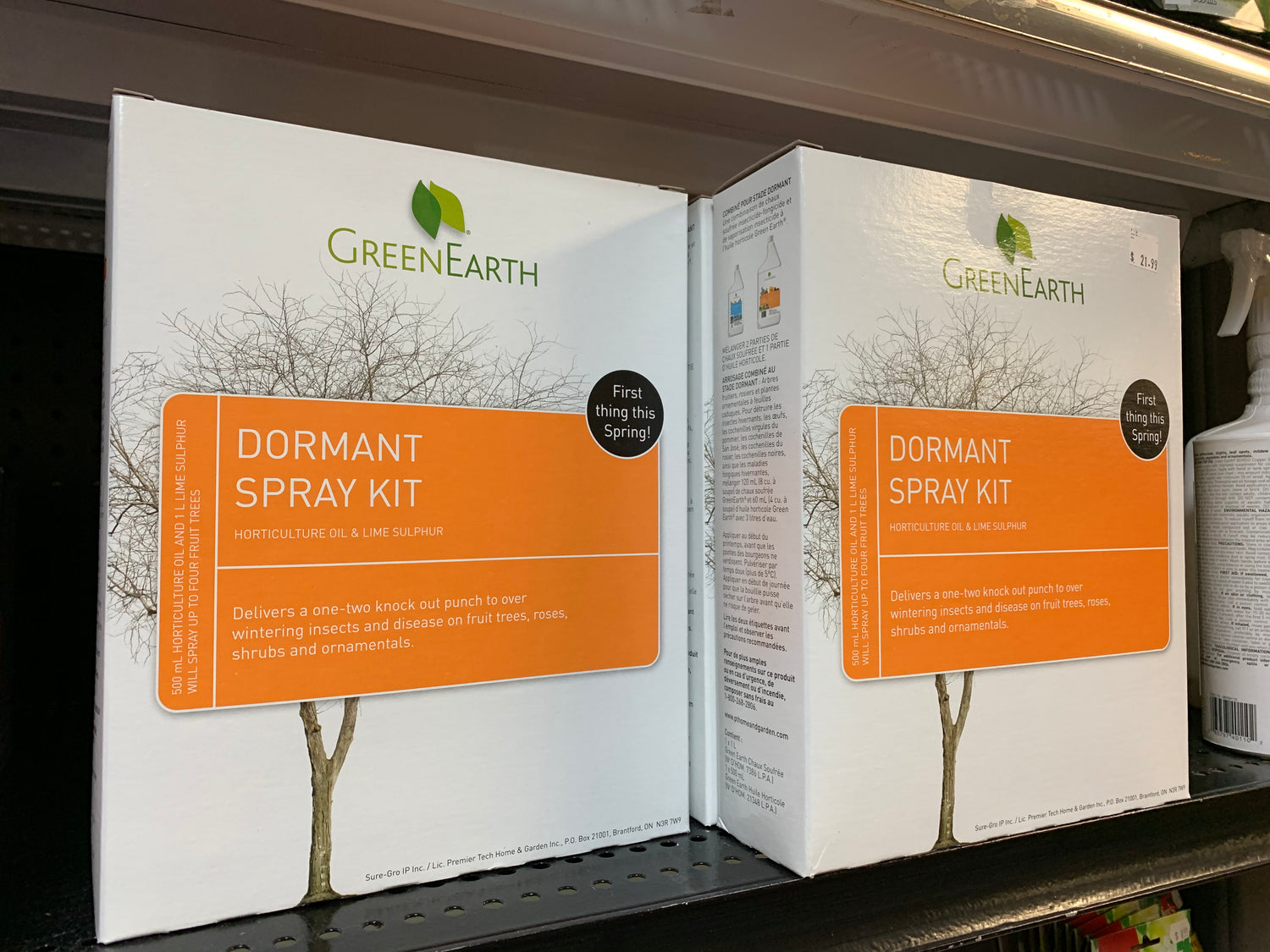
Ask The Experts!
We don't just sell trees, we are here to share our knowledge and offer continues support as you learn to care for your trees! At the Glasshouse we love to educate and share our experience to help you succeed!

All Of Our Water Treatments are Wildlife Safe!
Fruit Trees Require Your Attention Mid-Winter
Mid winter is a crucial time for fruit tree maintenance. As the trees are dormant during this time, it provides an excellent opportunity to carry out important tasks that will promote healthy growth and abundant fruit production in the coming season.
During mid winter, fruit trees require proper care and attention to ensure their overall health and productivity. This includes pruning, fertilizing, and protecting them from harsh weather conditions. By taking the time to perform these tasks, gardeners can help their fruit trees thrive and produce a bountiful harvest in the upcoming season.
Important Steps - Details Below
Dormant Spray Kit
Apply Dormant Oil Spray Every Spring Prior To Buds Popping!This preventative measure eliminates MOST problems! It protects their buds, foliage, pollination, bloom and fruit! Like we said above, common fungi and insects that affect fruit trees and roses are the over-wintering kind. They hibernate on your plants and can cause great damage to new buds in early spring! If left untreated they problem keeps arising.
Pruning
Mid winter is the ideal time to prune fruit trees as they are dormant and have shed their leaves. Pruning helps to shape the tree, remove dead or diseased branches, and improve air circulation within the canopy. This reduces the risk of disease and promotes new growth in the spring. For example, apple trees should be pruned to an open center shape to allow sunlight to reach all parts of the tree and encourage fruit production.
Fertilizing
Fruit trees benefit from a balanced fertilizer application in mid winter to replenish nutrients in the soil. This helps to support healthy growth and fruit development in the coming season. Organic fertilizers, such as compost or manure, can be applied around the base of the tree and lightly worked into the soil. This provides a slow release of nutrients that will benefit the tree over time.
Protection From The Harsh Winter
Mid winter can bring harsh weather conditions such as frost, snow, and strong winds that can damage fruit trees. To protect them, gardeners can wrap the trunks with tree wrap or burlap to prevent sunscald and frost cracks. Mulching around the base of the tree helps to insulate the roots and retain moisture in the soil. Additionally, using windbreaks or barriers can shield the trees from strong winds and prevent damage to the branches.
Dormant Spray Kit
Complete harvests can be lost from the damage caused by
early over-wintering insects. Taking the Dormant Oil approach will prevent the
need to use harsher chemicals in-season, which can leave a toxic residue.

Dormant oil spray kit consists of a mix of two widely used
products in the horticulture industry: Horticultural Oil and Lime Sulphur. Horticultural oil is known for its ability to suffocate insects and their eggs, while Lime Sulphur is effective against fungi and bacteria.
Dormant Oil
The horticultural oil is generally a light-weight mineral oil and works by covering over-wintering bugs and insect eggs, thereby smothering them or interrupting
their metabolism and causing them to starve. It is important to apply
Horticultural Oil when your plants are dormant, before they start to bud out.
*It is very important for your pollinator friends that you never apply it once the blooms appear, as horticulture oil will harm them as well.
Lime Sulphur
Lime sulphur works in much the same way except it primarily
targets fungal diseases that over-winter on your plants as well some insects.
Horticulture Oil and Lim Sulphur are mixed together during winter application, however lime sulphur can be used safely year round.
Aphids | Mites | Scales | Black Spot | Tar Spot | Mildew
When used at the proper time of the year, these insects and
re-occurring fungus problems, along with many other pests are eliminated before
they have a chance to become a problem. No matter how you look at it, dormant
oil goes a long way toward destroying bugs and disease early in the growing
season and reducing your need (and time) to use on pesticides on the fruit you
intend to use.
The Most Important Part Of This Maintenance Is When And How To Apply.
Dormant Oil should be applied in very late winter or early spring, this will vary slightly year to year. Due to this winters mild temperatures it will be upon us very soon!. You need to make sure of the following:
1. No frost or rain in the forecast for at least 24 hours. Temperature must be above 5 degrees Celsius. Due to the cooler nights, opt to do it in the morning on a sunny day, so that the spray has a chance to dry before nightfall
2. Spray must be applied before the dormant buds begin to break (just as they begin to swell, but before you can seen traces of colour from the emerging leaves)
Read all directions on the
package, and mix only what you will use. Give the sprayer a vigorous shake to mix thoroughly. Now you are ready to spray!
Helpful Tips For Healthy And Thorough Application:
Although these are organic products take care when spraying. Stand upwind of the breeze, and spray the plant from top to bottom, making sure every square inch is thoroughly wet. Remember to shake the sprayer periodically to keep the solution well mixed.
Fertilizing
Fruit trees benefit from a balanced fertilizer application in mid winter to replenish nutrients in the soil. This helps to support healthy growth and fruit development in the coming season. Organic fertilizers, such as compost or manure, can be applied around the base of the tree and lightly worked into the soil. This provides a slow release of nutrients that will benefit the tree over time.
Opt for nitrogen-rich fertilizers for topsoil blending in early spring. It requires ample nutrients to cultivate a bountiful harvest so be sure to regularly nourish your fruit trees.
Pruning Fruit Trees
At the garden centre, the fruit trees offered for sale may
be three years or older and the basic shape already begun or established,
having been pruned at the nursery. You need now only to maintain and improve
the open-centred vase shape that is desirable.
** It is important to prune during mid-winter while the tree is dormant. Select three
or four well-spaced branches that radiate evenly from the trunk. Details Below.
-

Never Pruned Before
A whip or maiden, when planted, should be cut back to these heights, depending on which fruit it is.
Peaches and Apricots - 60 cm Apple, Pear, Plum and Cherry - 100 cm
-

Side Shoots Have Started
If the main trunk has already been pruned back and your tree is further along, prune any side branches back to two buds. If the leader has not been pruned back yet, ensure to accomplish that at the same time.
-

Ensure Proper Spacing Between Branching
There should be a minimum of 15cm vertically between branches. Fruit trees perform best when the centre of the branching is open.
By the third winter, the basic scaffold of three or four main branches is established. Retain the best-placed shoots near the tip of each branch and one or two other side shoots.
Always cut to an outward-facing bud to maintain an open centre. The more horizontal the branching, the more, and the earlier the fruiting will occur.

Pruning And Thinning A Fruit-Bearing Tree
Summer pruning intentions are solely to remove leafy foliage and expose the ripening fruit to more sun. This should be done about a
month before the picking date.
-
Apples
The fruit is borne on long-lived "spurs" on the secondary branches. Allow only one apple per spur for larger fruit. Thin out the fruit on the branch mid-way to the maturity date, leaving 20 cm between fruit. Do not damage the spur when picking, as it will bear fruit again next year. Turn the apple bottom up and lift. ** Do not pull down or the spur may pull away.
-
Cherries
No thinning of fruit required. They can be allowed to bear heavily. A protective netting will be needed to prevent birds from taking the fruit.
We have different options in store for bird netting.
-
Plums
European Plums have long spurs and do not usually need thinning. Leave 10 cm between fruit. Japanese Plums have very short spurs and overbear. Thin fruit when they reach the size of your thumbnail, leaving 10 to 15 cm between fruit.
-
Pears
Pears are very similar to apples but you'll notice that they require less pruning. Allow only one pear per spur for larger fruit. Thin out the fruit on the branch mid-way to the maturity date, leaving 20 cm between fruit. Do not damage the spur when picking, as it will bear fruit again next year. Turn pear bottom up and lift. ** Do not pull down or the spur may pull away.
-
Apricots
Heavy pruning is needed to keep the Apricot producing. The
best shape is low and wide-spreading with no long branches. Thin and head back every year in winter. Fruit can be produced on the growth made last season, but
the bulk will be on four-year-old spurs. Encourage new spurs by pinching back laterals when they are about 10 cm long. -
Peaches and Nectarines
The open-centred vase shape is important in allowing
sunshine to reach the lower inside of the tree. Always cut to outward-facing lateral branches.
Note that fruit is formed only on the branch segments that grew last summer. New wood grows on beyond the fruit and will produce next year's crop. Once harvested, the fruiting section will never fruit again, so cut back two-year-old stems to promote new growth.










